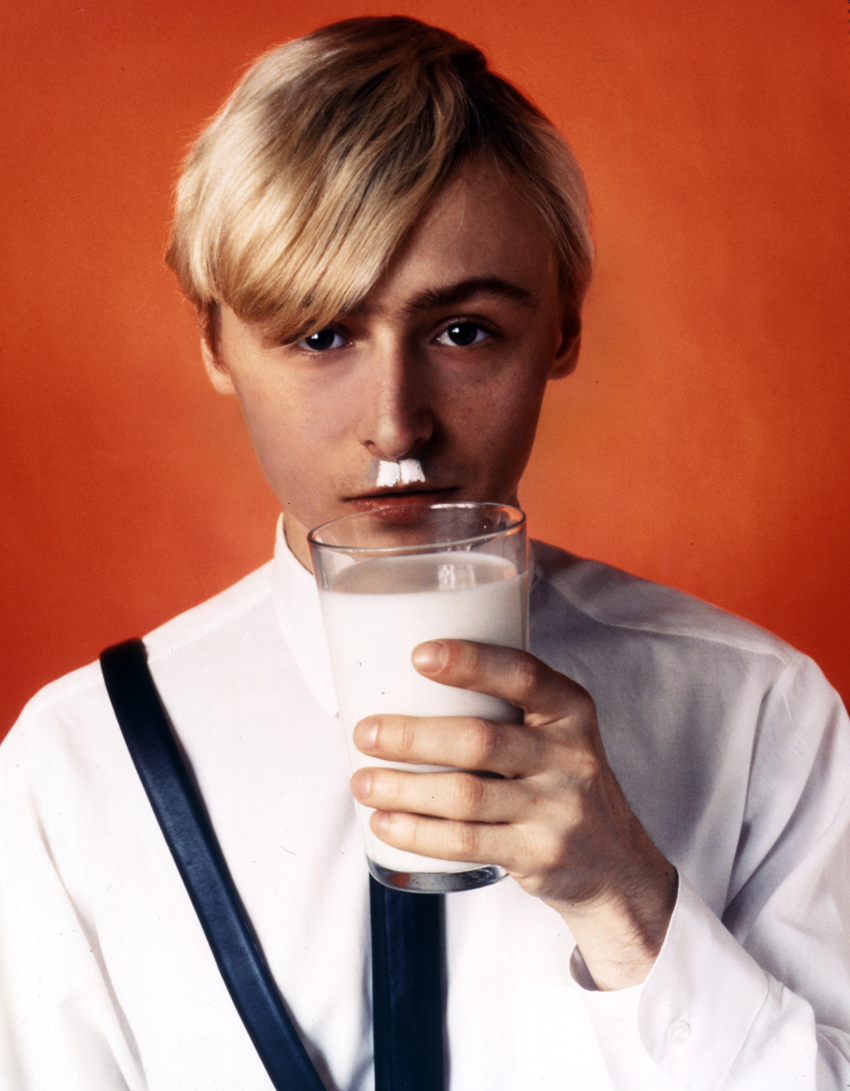 Image: General Idea, “Nazi Milk” (1979–90)
Image: General Idea, “Nazi Milk” (1979–90)
Real-Time Realness: From General Idea to Bernadette Corporation
by Justin Polera
“There is reality shortage. And General Idea is doing something about it.” (General Idea)
“Only the impossible is worth the effort.” (Bernadette Corporation as Reena Spaulings)
Truth can be stranger than fiction, but fiction can be realer than reality. In this way the group of artists in the exhibition New Group Materialism can be seen through the lens of art historical realism. What is most real about the work is that the artists to varying degrees escape the artificial boundaries of copyright (the right to copy), the very legal framework that mega-economies depend on. They travel freely through broadcasting, main steam culture, advertising and communication systems. They work to circulate the most important element of reality, the image. The image, which is so often seen as a fiction, (just an illusion or myth) as opposed to measurement and scientific “truth”, is the way to access the real.
In 1979 in New York City a group of artists, activist, curators, public intellectuals and writers came together under the name Group Material. In that same year the Canadian collective General Idea was invited by de Appel to Amsterdam to use a film crew inside the studios of the Stedelijk Museum to create a television show intended to be broadcast on a counter-cultural station. What came out of their invitation was the video, Test Tube, which is the point of entry for this exhibition. The video was never broadcast because it looked too much like television and not enough like art.
Central to the work of General Idea and is the impulse to circumvent representation, a picture of the world, in favor of a more direct engagement with the world. They were surrealist capitalist. Although each of the artists included works in very different ways their work shares formal qualities, photoshopped, polished, richly saturated, in the language of commercial imagery – the corporate aesthetic. Simultaneously complicit and adversarial to the mechanisms of the cultural economy they infect culture with new reality. The expansive and immersive work Imagevirus by General Idea took place simultaneously from 1984-1994 in cities across the globe and took the shape of an image disseminating and circulating through mass media, television, internet, newspaper and billboards.
The artist/theorist Hito Steyerl works with the “reality of images” by which she has described, “the reality we live in consists of images because images at a certain point have started crossing the screen and materializing within reality”, similar to the imagevirus the crossing of the image bruises and damages the images. The very sense of reality that these artists describe in their work is post-representational, revealing something essentially real beneath the surface—by eliminating everything from their work except the surface, it cracks under the after-effects of its own technique. Manipulating the corporate image as a material and strategy they photoshop photoshopped images, coopt logos, re-brand brands, design with graphic design, and shine up the glamorous surface.
By shamelessly appropriating the language of corporate aesthetics they exploit the strategies of marketing (including so called “research and development”) to crack open the very varnish of media images they are presenting. Using time itself as material object these artists reverse histories, remember the forgotten and reveal the mythologies of the future that are encoded in the present. They work in Real-Time. The term parallel projects applies to the positioning of these artists not as antagonistic to mass media broadcasting imagery, but ambivalent to it.
AA Bronson one of the threesome that exists as General Idea Corporation (legally incorporated) stated most clearly the parallel “ the current reality wasn’t sufficient enough for us, or we didn’t feel we belonged, so we had to create our own world, which was kind of a parody, and imperfect simulacrum of a perfect world.”
They aimed to close the gap between art and life even more and to collapse the processes of representation, consumption and production. As collectives these artists worked to radically fracture the solo voice as an authority and its heroic gesture. There are artists included who have left collectives or never worked in them but they shift away from the individual aesthetic to a more time-based, situation based work that fully embraces a mutability of meaning.
Why the sudden return to realism among a group of artists working in the second decade of the twenty-first century? Many of the artists included were born after the late 1980’s after the fall of the Berlin wall and the birth of the Internet. For one, artists now are working along side a renewed explosion in artist publishing as the Internet is a platform for production and presentation of user-generated content. Artist publishing is one route into exploiting copyright.
Bernadette Corporation doesn’t seem to even consider copyright let alone work against it. They are more cynical and nihilistic than General Idea who still had utopian myths. The BC corporate story points to one more level of distancing and remove an increasing ambivalence to fashion marketing. Where General Idea said that to survive an artist had to steal from consumer culture “glamour is theft. It requires the mind of a criminal. Collage or prish. Cut up or shut up” the Bernadette Corporation works to buy, license or fake high fashion imagery.
 Image: Bernadette Corporation
Image: Bernadette Corporation
Justin Polera is a writer, activist, gallerist and independent curator living and working in Berlin.
New Group Materialism is live on Tank.tv until November 8th and includes work by AIDS3D, Auto Italia, Bernadette Corporation, BessNYC4, Debora Delmar Corp, DIS, Awol Erizku, General Idea, LuckyPDF, Yuri Pattison, Shanzhai Biennial and Hito Steyerl.